
The balalaika is a Russian stringed musical instrument with a characteristic triangular wooden, hollow body, fretted neck, and three strings. Two strings are usually tuned to the same note and the third string is a perfect fourth higher. The higher-pitched balalaikas are used to play melodies and chords. The instrument generally has a short sustain, necessitating rapid strumming or plucking when it is used to play melodies. Balalaikas are often used for Russian folk music and dancing.
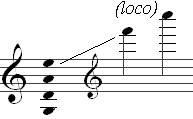
A mandolin is a stringed musical instrument in the lute family and is generally plucked with a pick. It most commonly has four courses of doubled strings tuned in unison, thus giving a total of eight strings. A variety of string types are used, with steel strings being the most common and usually the least expensive. The courses are typically tuned in an interval of perfect fifths, with the same tuning as a violin. Also, like the violin, it is the soprano member of a family that includes the mandola, octave mandolin, mandocello and mandobass.

Vaslav or Vatslav Nijinsky was a Russian ballet dancer and choreographer of Polish ancestry. He is regarded as the greatest male dancer of the early 20th century.

Anton Stepanovich Arensky was a Russian composer of Romantic classical music, a pianist and a professor of music.
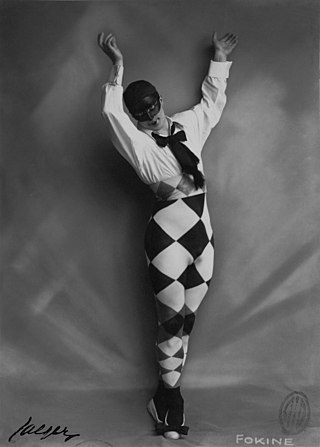
Michael Fokine was a Russian choreographer and dancer.

The Ballets Russes was an itinerant ballet company begun in Paris that performed between 1909 and 1929 throughout Europe and on tours to North and South America. The company never performed in Russia, where the Revolution disrupted society. After its initial Paris season, the company had no formal ties there.

Bernardo De Pace was an actor, musician and comedic vaudeville entertainer of the 1910s and 1920s, billed as "the Wizard of the Mandolin". He learned to play mandolin in the Italian tradition under Francesco Della Rosa. De Pace's repertoire and technique was described in the Brooklyn Life as involving "the most difficult violin and piano compositions, executed at inconceivably rapid tempi demanding an uncanny technique seldom heard on fretted instruments". In 1927 the Minneapolis Star said that he had been recognized as one of the best mandolinists in the United States. It added that he was more than a mandolinist, that his skill was in playing on human emotions as few musicians were able.
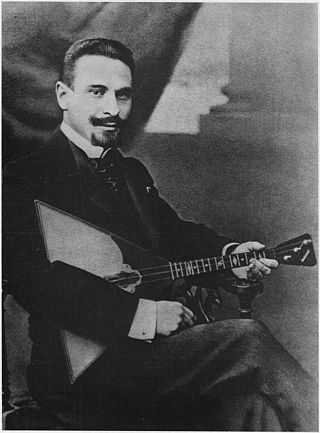
Vasily Vasilievich Andreyev was a Russian musician responsible for the modern development of the balalaika and several other traditional Russian folk music instruments, and is considered the father of the academic folk instrument movement in Eastern Europe. His accomplishments included:

Ludwig Minkus, also known as Léon Fyodorovich Minkus, was an Austrian composer of ballet music, a violinist and teacher of music.
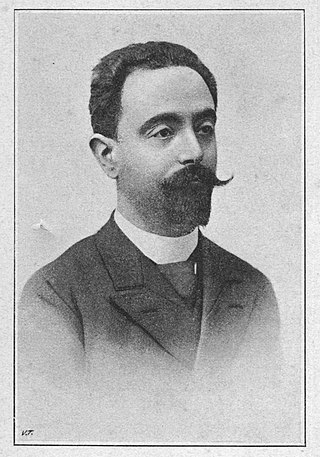
Carlo Munier (1858–1911) was an Italian musician who advocated for the mandolin's acknowledgement among as an instrument of classical music and focused on "raising and ennobling the mandolin and plectrum instruments". He wanted "great masters" to consider the instrument and raise it above the level of "dilettantes and street players" where it had been stuck for centuries. He expected that the mandolin and guitar would be taught in serious orchestral music schools and incorporated into the orchestra. A composer of more than 350 works for the mandolin, he led the mandolin orchestra Reale circolo mandolinisti Regina Margherita named for its patron Margherita of Savoy and gave the queen instruction on the mandolin. As a teacher, he wrote Scuola del mandolino: metodo completo per mandolino, published in 1895.
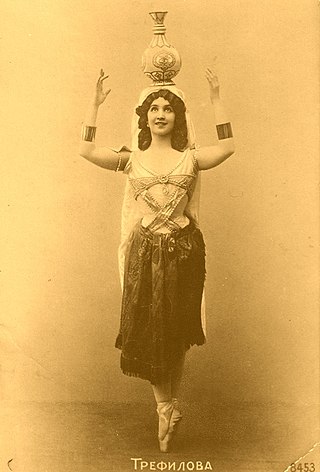
Vera Trefilova was a Russian dancer and teacher.

Dave Apollon was an American mandolin player.
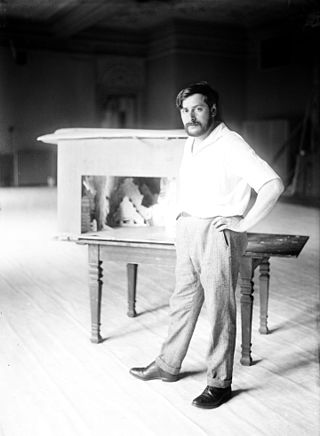
Boris Izrailevich Anisfeld (1878–1973) was a Russian-American painter and theater designer.

Joseph Frederick Brent is an American composer, mandolinist, multi-instrumentalist, and teacher. He is known for his performances and arrangements of rock and indie songs, as well as his original compositions with the ensemble 9 Horses. He taught classical mandolin at Mannes College and currently teaches at Bard College.

Antonio Luigi Embergher was an Italian luthier known for his high quality bowlback mandolins. Son of the ebanist Pietro Embergher and Maria Ciccarelli, Born in Arpino 1856.

Giuseppe Branzoli was a violinist, mandolinist, composer, author, educator at the Liceo Musicale di St. Cecilia in Rome, and the founder of the periodical IL mandolin Romano. His compositions were for violin, mandolin, flute and cello, as well as church music.

Domenico Della Maria was a mandolin virtuoso and dramatic composer of operas.
Ugo Orlandi is a musicologist, a specialist in the history of music, a university professor and internationally renowned mandolinist virtuoso. Among worldwide musicians, professional classical musicians are a small group; among them is an even smaller group of classical mandolinists. Among members of this group, Ugo Orlandi is considered "distinguished." Music historian Paul Sparks called him "a leading figure in the rehabilitation of the eighteenth-century mandolin repertoire, having recorded many concertos from this period."

Following its invention and development in Italy the mandolin spread throughout the European continent. The instrument was primarily used in a classical tradition with mandolin orchestras, so called Estudiantinas or in Germany Zupforchestern, appearing in many cities. Following this continental popularity of the mandolin family, local traditions appeared outside Europe in the Americas and in Japan. Travelling mandolin virtuosi like Carlo Curti, Giuseppe Pettine, Raffaele Calace and Silvio Ranieri contributed to the mandolin becoming a "fad" instrument in the early 20th century. This "mandolin craze" was fading by the 1930s, but just as this practice was falling into disuse, the mandolin found a new niche in American country, old-time music, bluegrass and folk music. More recently, the Baroque and Classical mandolin repertory and styles have benefited from the raised awareness of and interest in Early music.


















